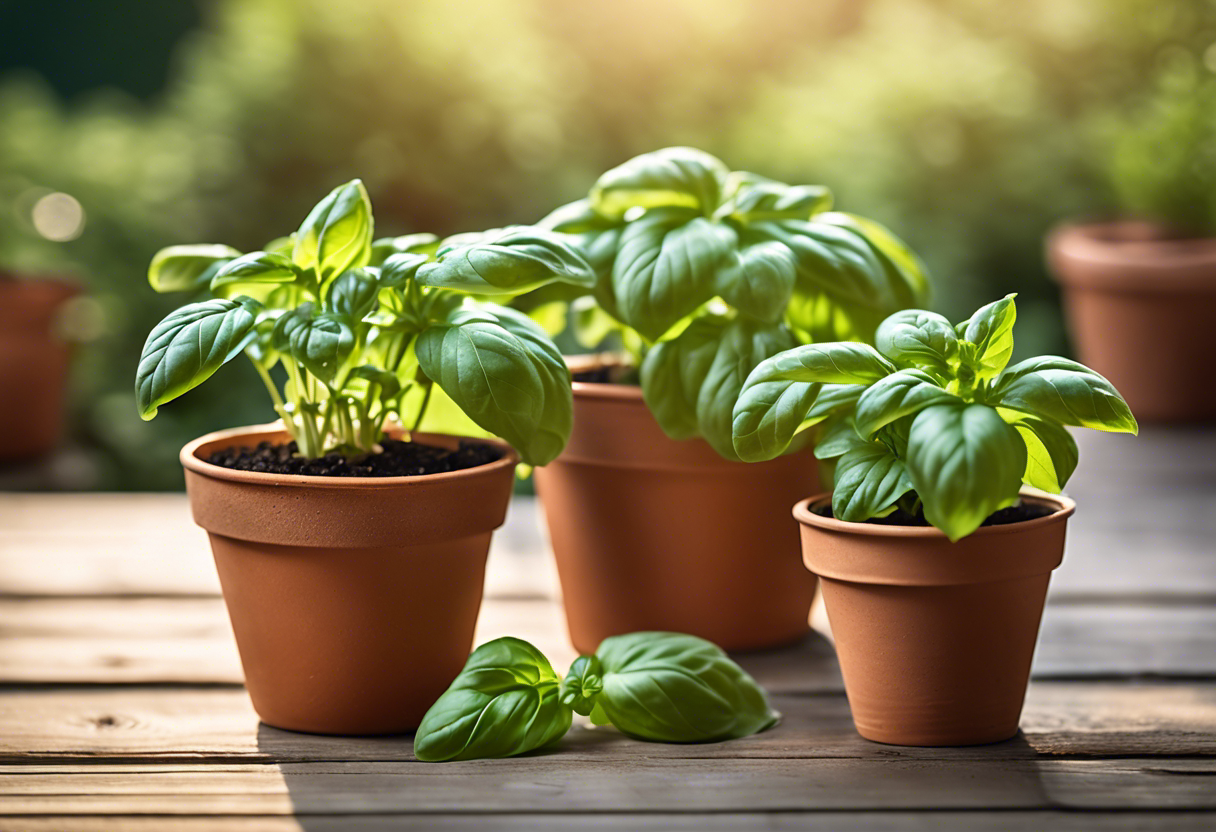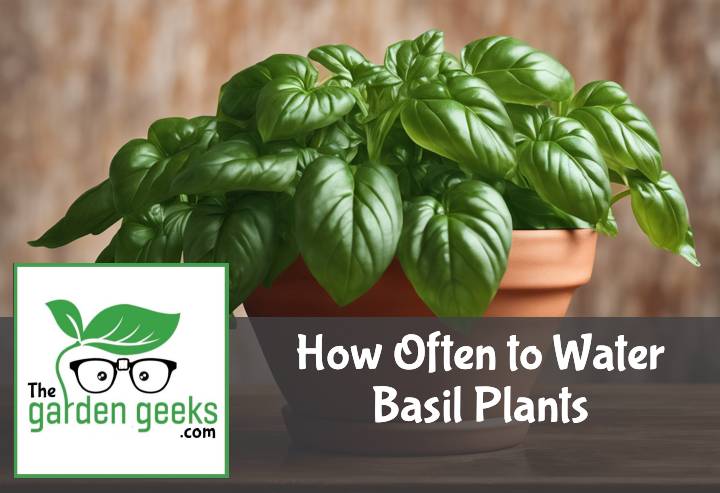Ever looked at your basil plant and wondered, “Are you thirsty, buddy?” I know I have. That’s why we’re diving into the topic of How Often to Water Basil Plants today. Oh yeah, it’s about to get real ‘plant-parenty’ up in here.
Now, don’t freak out! I promise this won’t be as complex as trying to understand your cat’s mood swings. We’ll keep it light-hearted and informative. So grab a cuppa, sit back and let’s unravel this green mystery together. Keep reading about How Often to Water Basil Plants!
Key Takeaways
- Basil plants should be watered when the top 1 inch of soil is dry, typically every 3 to 4 days.
- Overwatering can cause root rot and kill the plant.
- Water basil deeply to encourage strong root growth.
- Adjust watering frequency based on weather conditions; more frequent in hot, dry climates and less in cooler, humid areas.
- Indoor basil plants may require less frequent watering than outdoor ones.

Understanding Basil Plant’s Watering Needs
When it comes to basil plant care, getting the watering right is like hitting a bullseye. It’s not just about keeping the soil damp, but also about understanding your basil’s unique hydration needs. The question of how often to water basil plants isn’t one-size-fits-all, and depends on several factors.
The Importance of Water for Basil Plants
Water plays a starring role in the health and growth of your basil plants. It’s like the secret sauce that keeps everything running smoothly. Without enough water, your basil might as well be on a one-way trip to plant heaven.
But why is water so important? Well, it helps transport nutrients from the soil to the plant. This process, known as basil plant hydration, is vital for promoting healthy growth and maintaining overall plant health.
In other words, if you want your basil plants to thrive and not just survive, you’ve got to keep them well-watered. But remember – too much love (or water) can be a bad thing!
Factors Influencing Water Requirements
So how do you know when your basil is thirsty? There are several factors that affect watering requirements for basil.
First off, temperature plays a big role. On hot days, your basil will need more water than usual because it evaporates faster from the soil. Similarly, if your plant is in direct sunlight all day long, it’ll need more frequent watering compared to its shady counterparts.
Another factor is the size of your plant. Bigger plants with more leaves need more water than smaller ones because they have a larger surface area through which they lose moisture.
Lastly, don’t forget about soil type! Different soils have different capacities for holding onto water. So depending on whether you’re dealing with sandy or clayey soil, you might need to adjust your watering schedule accordingly.
Remember folks, understanding your basil’s water needs is a bit like being a plant detective. It’s all about observing and adjusting to the conditions!
How Often Should You Water Basil Plants?

When it comes to watering basil plants, there’s no one-size-fits-all answer. The frequency depends on a variety of factors, including whether you’re dealing with indoor or outdoor plants, the time of year, and the plant’s own tell-tale signs of thirst.
Indoor vs. Outdoor Basil Plants
Indoor and outdoor basil plants have different hydration needs. Indoor basil watering is typically more frequent because indoor air can be drier due to heating or air conditioning. On the other hand, outdoor basil care involves considering elements like rain and humidity that naturally hydrate the plant.
The environment impact on plants is significant, so understanding your specific setting is key in determining how often to water your basil. Remember, overwatering can be just as harmful as underwatering when it comes to indoor vs outdoor gardening.
Seasonal Variations in Watering Frequency
Seasons play a big role in your basil plant’s water requirements too. During summer months, you might find yourself doing more summer basil watering, thanks to higher temperatures and increased sunlight hours.
However, come winter, your plant’s hydration needs will decrease due to lower light levels and cooler temperatures – this is where winter plant hydration comes into play. Always remember that the temperature effect on watering frequency can’t be ignored when figuring out how often to water basil plants.
Signs Your Basil Plant Needs Water
Your basil plant will give you visual cues when it’s thirsty. One of the most common basil plant dehydration signs is wilting leaves – if they look droopy or limp, it might be time for a drink.
Another sign could be color changes in your plant’s leaves – if they’re turning yellow or brown, that’s another SOS from your green buddy! So keep an eye out for these signs and remember, recognizing thirsty plants is a crucial part of plant care.

Best Practices for Watering Basil Plants
When it comes to basil plant care, the watering process isn’t just a splash and dash affair. It’s an art, a science, and a dance with nature all rolled into one. You see, watering basil plants correctly is key to maintaining those healthy basil plants you’re after.
Correct Time to Water Basil Plants
So when exactly should you water your basil? Well, the best time for watering basil is in the morning. This gives your plant plenty of time to drink up before the midday heat arrives.
But remember, seasonal watering of basil changes things up a bit. In hot summer months, your basil might need a little extra H2O love. On the flip side, during cooler seasons or cloudy days, ease up on the waterworks.
Ideal Amount of Water for Basil Plants
Now let’s talk quantity. How much water does your green buddy need? Well, it depends on a few factors like pot size and plant maturity. A general rule of thumb is that mature plants need more water than their younger counterparts.
But don’t drown them! Overwatering can be just as harmful as underwatering. So keep an eye out for signs like yellow leaves or wilting – they might be silently screaming “Help! I’m swimming here!”
Ensuring Proper Drainage
And finally we come to drainage – an often overlooked but crucial part of basil growing conditions. Good drainage ensures that excess water doesn’t sit around the roots causing all sorts of problems like root rot.
If you notice your plant looking a little under the weather despite regular watering, poor drainage could be the culprit. The solution? Make sure your pots have adequate drainage holes and consider using well-draining soil mixes designed specifically for herbs like basil.
Remember folks: when it comes to figuring out how often to water basil plants, it’s all about balance. Happy watering!
Common Mistakes When Watering Basil Plants
When it comes to basil plant care, watering is a delicate balance. Too much or too little can spell disaster for your green friend. Let’s dive into the common gardening mistakes of overwatering and underwatering basil plants.
Overwatering and Its Consequences
Overwatered basil plants are a sorry sight. The leaves turn yellow, wilt, and might even fall off. This is because the roots are waterlogged and can’t breathe. It’s like trying to swim with your boots on – not fun at all!
The effects of overwatering are pretty grim. Your basil could develop root rot, a nasty condition that can kill your plant if not addressed promptly. Plus, overwatered basil symptoms often attract pests like fungus gnats who love damp conditions.
Damage from overwatering isn’t just about soggy soil though. It also affects nutrient absorption, meaning your plant might be starving even in rich soil! So remember folks, don’t drown your herbs in love (or water).
Underwatering and Its Impact
On the flip side, underwatering isn’t any better for your basil plants either. Leaves may droop or curl up when they’re thirsty. If you notice this happening, it’s time to give them a drink!
The effects of underwatering can be quite severe as well. Basil plants need consistent moisture to grow properly. Without enough water, they’ll become stressed and growth will slow down.
Damage from underwatering includes wilting leaves and stunted growth but don’t despair! With proper basil plant care, you can nurse an underwatered plant back to health.
So there you have it folks! Knowing how often to water basil plants is key but avoiding these common mistakes is equally important!

To Wrap Up
Just like a toddler needs a balanced diet, your basil plants need the right amount of water. The ‘Goldilocks’ approach – not too much, not too little – is key in understanding How Often to Water Basil Plants.
So, put on your gardening gloves, grab that watering can and give your basil baby just the right sip! Remember, happy plants make for even happier chefs!


